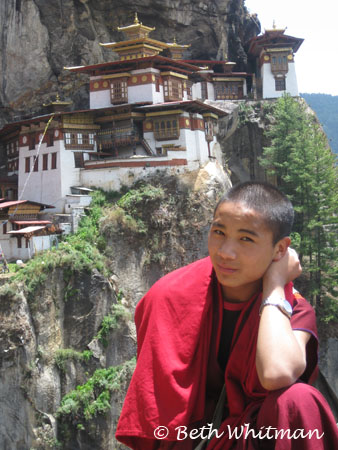 This 12-day custom itinerary is specially crafted for those with a particular interest in Buddhism and want to better understand the Kingdom through their religion and the country’s philosophy of Gross National Happiness.
This 12-day custom itinerary is specially crafted for those with a particular interest in Buddhism and want to better understand the Kingdom through their religion and the country’s philosophy of Gross National Happiness.
You will be led by an experienced guide who has a deep-rooted understanding of the Buddhist way of life in Bhutan as well as knowledge of the country’s history and culture. You’ll have time to enjoy the natural environment and overall spiritual facets of Bhutan which permeate throughout the Himalayas.
This itinerary may be personalized to match your particular interests and time frame.
Call or email today for your personalized itinerary:
beth (at) WanderTours (dot) com
206-317-1860
Day 1 – Arrive in Bhutan – Paro
Arriving in Bhutan, you’ll immediately enjoy the magnificent beauty of the region. On a clear day, spectacular vistas of the Himalayas, the world’s highest mountains, make way for the rich, green Paro Valley. Stepping off the plane, you’ll be struck by the crisp, fresh air. You’ll be met by your guide and driver immediately after going through visa control and customs and then proceed to your hotel.
Following lunch, you may have the opportunity to visit the National Museum where you’ll see locally-made textiles, ancient armor, household objects, thangkas, weapons and many other artifacts. You may then visit Rinpung Dzong (monastery). If there’s time you’ll want to also walk Paro’s one main street to visit the local shops. Dinner and overnight in Paro.
Day 2 – Paro – Thimphu
After breakfast, you’ll depart for Thimphu, Bhutan’s capital (population 86,000; 7,520 feet) about an hour away.
After checking in to your hotel and having lunch, you’ll have a chance to visit sights around Thimphu, including the National Memorial Chorten, the National Zoo (which is more like a preserve given that the only animal there is the national animal, the unique Takin), a nunnery, the handicraft emporium, the handmade paper factory and perhaps Trashi Chhoe Dzong.
In the evening, you’ll have a private meeting with a local Buddhism scholar who will explain the history of the religion in Bhutan as well as current modern-day practices.
Dinner and overnight in Thimphu.
![]() HIGHLIGHT! Thimphu is the only capital city without a traffic signal. Although it is small in comparison to most cities in the world, it is the largest and only real city in Bhutan. It’s a great place to see and learn about the arts and crafts that are produced throughout the country, much of it based on Buddhist beliefs.
HIGHLIGHT! Thimphu is the only capital city without a traffic signal. Although it is small in comparison to most cities in the world, it is the largest and only real city in Bhutan. It’s a great place to see and learn about the arts and crafts that are produced throughout the country, much of it based on Buddhist beliefs.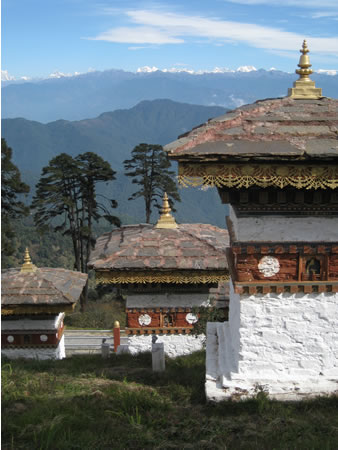
Day 3 – Thimphu – Punakha
Following breakfast, you’ll drive up to Dochu La Pass (10,000 feet) where you’ll see a memorial of 108 chortens at the top.
The road climbs through pine and cedar forests that are festooned with hanging lichen. If you like, you can take a downhill hour-long hike through the forest. The end of the trail ends up at the road where you’ll meet your car and driver. You’ll then continue on to the Punakha Valley where you’ll check into your hotel.
It’s just a short distance eastward to Punakha Dzong, which you’ll visit in the afternoon. You may have a chance to see and/or hear the resident monks during their daily prayers.
Dinner and overnight at hotel which is perched high on a ridge overlooking the Punakha Valley and river.
![]() HIGHLIGHT! Considered to be one of the most beautiful monasteries in Bhutan, Punakha Dzong sits at the confluence of two raging rivers. You’ll be able to walk all through this complex of buildings, where hundreds of monks stay during the winter. Here, you’ll visit the spectacular main temple that houses large Buddhas at the altar in addition to thousands more Buddha statues that are placed within the walls.
HIGHLIGHT! Considered to be one of the most beautiful monasteries in Bhutan, Punakha Dzong sits at the confluence of two raging rivers. You’ll be able to walk all through this complex of buildings, where hundreds of monks stay during the winter. Here, you’ll visit the spectacular main temple that houses large Buddhas at the altar in addition to thousands more Buddha statues that are placed within the walls.
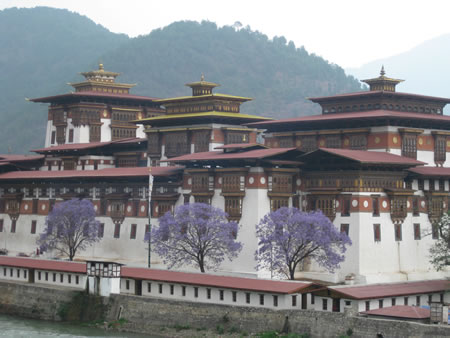 Day 4 – Punakha – Trongsa
Day 4 – Punakha – Trongsa
Today you’ll have a long drive (about 5 hours) to Trongsa. Along the way, you’ll be driving through the Black Mountains on the country’s “Central Road.” This was completed just over 30 years ago and essentially opened much of Bhutan to the rest of the world.
The first stop along the way is the small village of Wangdue. This town is important because it’s the district headquarters of Western Bhutan. You’ll have a chance to visit Wangdue Phodrang Dzong which is dramatically perched on a hill with beautiful views of the valley below. Continuing on the highway, you’ll be climbing through semi-tropical vegetation up to Pele La Pass (10,900 feet) which has an alpine environment of towering rhododendron as well as dwarf bamboo. Often you’ll be able to see yak grazing along the roadside. If the weather is clear, you’ll have a view of Mt. Jhomulhari (24,140 feet), visible to the west, and one of Bhutan’s most sacred mountains. Once you start descending, you’ll be passing through a spectacular gorge and then head onward to Trongsa.
Dinner and overnight at hotel in Trongsa.
Day 5 – Trongsa – Bumthang Valley
After breakfast, you’ll continue east toward the Bumthang Valley, considered the seat of Buddhism in Bhutan. Here, you’ll have plenty of time to visit many of the regions wonderful sights including several temples such as: Kurjey Lhakhang, the Tamshing Gompa (monastery), Jambay Lhakhang and the Jakar Dzong. If time permits, you might also visit the Swiss Farm where you can buy cheese, honey, beer and local fruit spirits.
Dinner and overnight in Bumthang.
![]() HIGHLIGHT! Bumthang Valley is a lovely, relaxed area and is perfect for settling in for a few days to learn about the origin of Buddhism in Bhutan and enjoy the architecture, sights, rich culture and spiritual surroundings.
HIGHLIGHT! Bumthang Valley is a lovely, relaxed area and is perfect for settling in for a few days to learn about the origin of Buddhism in Bhutan and enjoy the architecture, sights, rich culture and spiritual surroundings.
Day 6 – Bumthang – Hike to Tang Valley 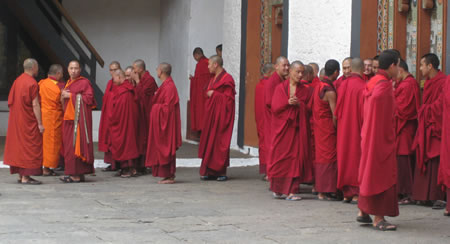
Following breakfast, you’ll leave for the Tang Valley which is a remote area at the end of 15 miles of rough dirt road. You’ll make the hour-long hike up to Ogyen Choling Museum which is a home-turned-museum that gives you an excellent look into traditional life in Bhutan. After walking back down to the road and your car, you’ll stop for a picnic lunch alongside the river.
Afterward, you’ll visit the Pema Choling Nunnery. This is a fascinating stop as you’ll learn about how the women here live and about how they operate this remote nunnery. It’s interesting because it is so different from the monasteries where the monks reside.
Dinner and overnight at same hotel in Bumthang.
![]() HIGHLIGHT! The road to the Tang Valley is rough, but the views and hike to the museum are spectacular. The museum itself gives is a unique chance to observe how the locals still live a traditional life in Bhutan.
HIGHLIGHT! The road to the Tang Valley is rough, but the views and hike to the museum are spectacular. The museum itself gives is a unique chance to observe how the locals still live a traditional life in Bhutan.
Day 7 – Bumthang – Ura – Bumthang
Following breakfast, today, you’ll take a drive to the Ura Valley, about 25 miles away. You’ll be able to take the easy hike down into the village and see this active but quiet town that thrives on potato farming. Depending on the time, you might have lunch along the way or back at the hotel in Bumthang.
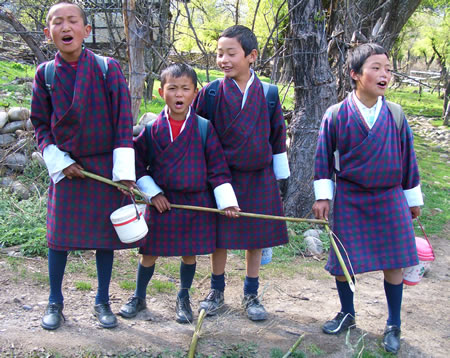
In the afternoon, you may have a chance to wander through the local village and be greeted by the school children returning home.
Dinner and overnight at same hotel in Bumthang.
Day 8 – Bumthang – Gangtey
After breakfast, you’ll begin the drive back west toward Paro. You can stop at Yotong La Pass for a break and then continue onward through Trongsa and over Pele La Pass. Soon after, you’ll turn south toward the Phoblika Valley (10’000 feet). This valley is considered to be the most beautiful valley in all the Himalayas and is the winter home to the endangered black-necked cranes. Lunch will be provided along the way.
Dinner and overnight in Gangtey/Phoblika Valley.
![]() HIGHLIGHT! While the black-necked cranes can usually only be found here from about November through March, when they arrive from the Tibetan Plateau, the Phoblika Valley is worth a visit any time of year.
HIGHLIGHT! While the black-necked cranes can usually only be found here from about November through March, when they arrive from the Tibetan Plateau, the Phoblika Valley is worth a visit any time of year.
Day 9 – Gangtey – Wangdue
After breakfast, you’ll have the chance to visit Gangtey Gompa, either by driving or taking the very steep hike up 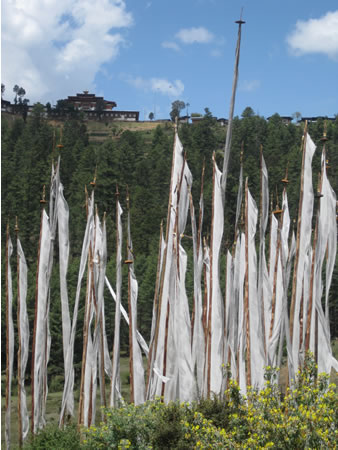 to it. This monastery dates back to the 17th century and was recently renovated. After visiting, you’ll walk back to the hotel through a beautiful forest and then along the valley floor. Lunch will be served at the hotel.
to it. This monastery dates back to the 17th century and was recently renovated. After visiting, you’ll walk back to the hotel through a beautiful forest and then along the valley floor. Lunch will be served at the hotel.
Afterward, you’ll drive 2 hours to Wangdue (4,000 feet) where you’ll check in to your riverside hotel. Dinner and overnight at in Wangdue.
![]() HIGHLIGHT! Gangtey Gompa is located at the top of a hill that overlooks the Phoblika Valley. This recently renovated monastery is one of the main seats of the Nyingmapa schools of Buddhism, based on Pema Lingpa’s revelations. Both the interior and exterior are extraordinary and hold secret treasures!
HIGHLIGHT! Gangtey Gompa is located at the top of a hill that overlooks the Phoblika Valley. This recently renovated monastery is one of the main seats of the Nyingmapa schools of Buddhism, based on Pema Lingpa’s revelations. Both the interior and exterior are extraordinary and hold secret treasures!
Day 10 – Wangdue – Thimphu – Paro
From Wangdue, you will drive back to Thimphu where you’ll have lunch and time for some shopping and final sightseeing. You might take this opportunity to purchase a thangka or other artwork that is representative of Buddhism.
You’ll then head on to Paro where you’ll have dinner and overnight.
Day 11 – Paro
On this, your final full day in Bhutan, you’ll get an early start in order to hike 2+ hours up to Taktsang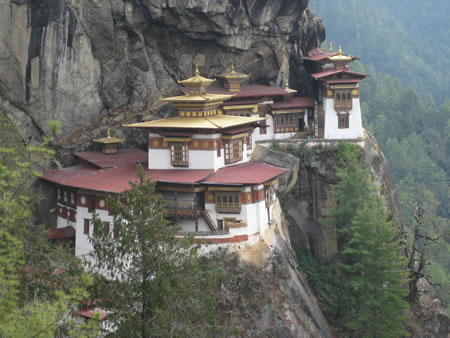 (Tiger’s Nest), Bhutan’s most photographed and iconic monastery. You’ll have time to enjoy the views and to visit the handful of temples here at the top. Consider carrying prayer flags, mala beads or other small items to have blessed by a monk at one of the temples at the top.
(Tiger’s Nest), Bhutan’s most photographed and iconic monastery. You’ll have time to enjoy the views and to visit the handful of temples here at the top. Consider carrying prayer flags, mala beads or other small items to have blessed by a monk at one of the temples at the top.
You’ll then head down the mountain, stopping at the tea shop/cafe, which is located at the halfway point and where there are beautiful views of Tiger’s Nest. You’ll be able to then enjoy a picnic lunch by the river.
In the afternoon, you’ll return to Paro. You’ll have time to rest or visit the town for last-minute souvenir shopping.
Final overnight and dinner in Paro.
![]() HIGHLIGHT! Hiking to Tiger’s Nest could quite possibly be the highlight of your entire journey. Because of the altitude, this is a somewhat demanding hike, but is very doable for most.
HIGHLIGHT! Hiking to Tiger’s Nest could quite possibly be the highlight of your entire journey. Because of the altitude, this is a somewhat demanding hike, but is very doable for most.
Day 12 – Paro – Departure
After breakfast, you’ll head to the airport for your flight home.
****
For help in customizing this or any other tour to Bhutan, please contact:
beth (at) wandertours (dot) com
206-317-1860
 Custom Tour to Bhutan – 7-day Highlights
Custom Tour to Bhutan – 7-day Highlights